Have you ever dreamt of a garden bursting with healthy vegetables, vibrant flowers, and minimal pest problems? Companion planting might be the key to unlocking this dream! This age-old gardening practice involves strategically placing different plants together to create a mutually beneficial ecosystem. Not only can it boost your harvest, but it also attracts helpful pollinators, deters pests naturally, and optimizes space in your garden.
We’ve been using companion planting for years with fantastic results, and today we’re sharing 20+ winning combinations. Get ready to transform your garden into a thriving haven of biodiversity and abundance!
1. Tomatoes & Basil: A Classic Culinary Duo

Tomatoes: These juicy summer staples require full sun and well-draining soil to produce their best fruit.
Basil: This aromatic herb not only adds a delightful flavor to your dishes but also plays a vital role in keeping tomato plants healthy.
Why this combination works: Basil acts as a repellent to some common tomato pests like whiteflies and hornworms. The strong scent of the herb disrupts their communication and makes them less likely to target your tomatoes. Additionally, interplanting basil among your tomato plants helps improve air circulation, reducing the risk of fungal diseases.
Planting Tips: Plant basil seedlings around the base of your tomato plants, maintaining a spacing of 12-18 inches. Both plants prefer full sun and consistent watering.
2. Peppers & Marigolds: Spice Up Your Pest Control
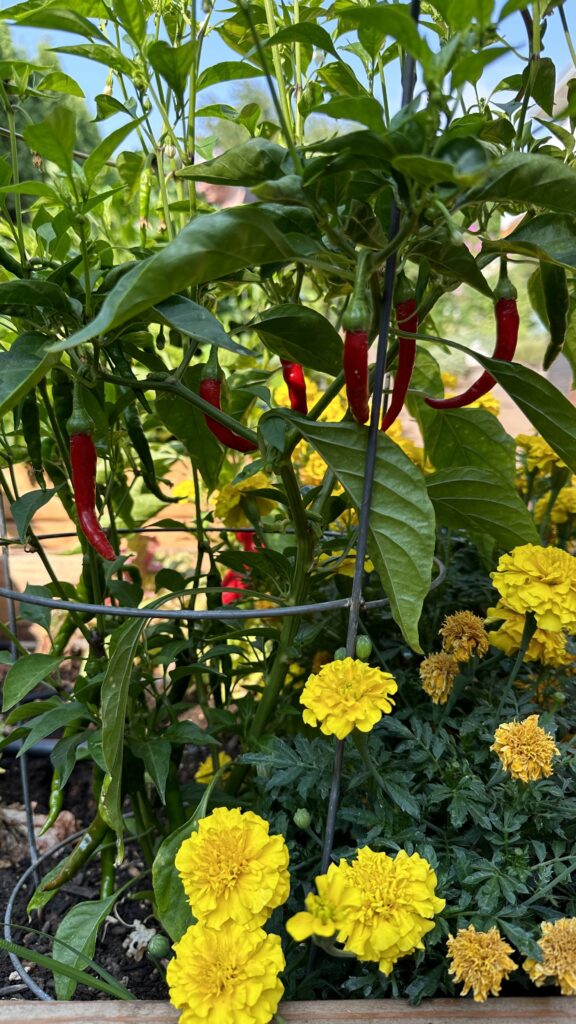
Peppers: These versatile vegetables come in various shapes, sizes, and spice levels. They thrive in warm temperatures and full sun.
Marigolds: These cheerful flowers not only add a splash of color to your garden but also pack a powerful punch against unwanted pests.
Why this combination works: Marigolds are renowned for their pest-repelling properties. Their strong scent deters aphids, thrips, and even whiteflies, which are common threats to pepper plants. Additionally, marigolds act as a trap crop, attracting these pests away from your precious peppers.
Planting Tips: Plant marigolds around the perimeter of your pepper bed, spacing them about 10-12 inches apart. Both plants appreciate well-draining soil and full sun.
3. Beans & Corn: A Nitrogen-Fixing Powerhouse

Beans: These legumes come in a variety of types, from green beans to black beans. They require moderate watering and prefer warm weather.
Corn: This tall stalky plant produces delicious ears of corn and enjoys full sun with consistent moisture.
Why this combination works: Beans are nitrogen-fixing plants, meaning they capture nitrogen from the air and convert it into a usable form for other plants. This can significantly improve the growth and yield of corn, which is a heavy feeder of nitrogen. Additionally, corn stalks provide much-needed support for climbing bean varieties, creating a natural trellis system.
Planting Tips: Plant corn seeds in rows about 3 feet apart. Sow bean seeds in between the corn rows a few weeks later, maintaining a spacing of 4-6 inches. Ensure both plants receive full sun and consistent watering.
4. Cucumbers & Dill: A Refreshing Partnership
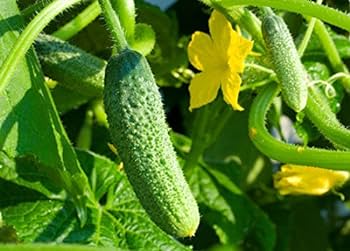
Cucumbers: These refreshing vining vegetables thrive in warm weather and require moist, well-draining soil.
Dill: This feathery herb boasts a bright, citrusy flavor and offers a surprising benefit for cucumbers.
Why this combination works: Dill is known to attract beneficial insects like hoverflies and parasitic wasps, which can help control cucumber beetles, a major pest for these vining vegetables. Additionally, dill may improve the flavor of cucumbers by enhancing their natural sweetness.
Planting Tips: Plant cucumber seeds in mounds spaced 3-4 feet apart. Sow dill seeds around the base of the cucumber mounds or in between the rows, maintaining a spacing of 8-10 inches. Both plants require full sun and consistent watering.
5. Lettuce & Carrots: Maximize Your Garden Space
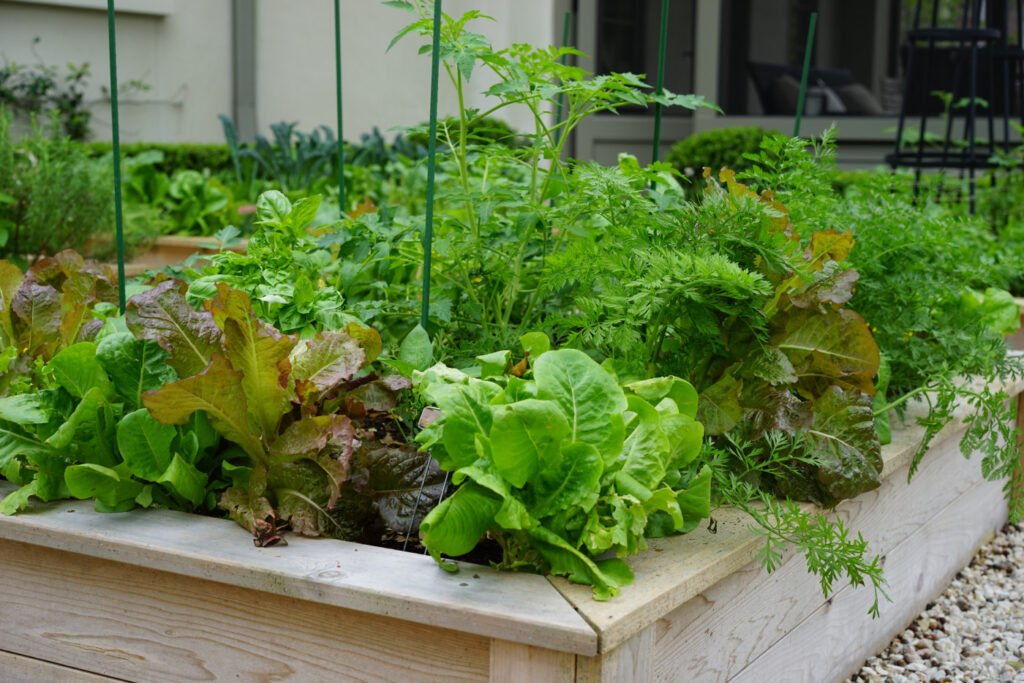
Lettuce: This leafy green is a versatile salad staple that enjoys cool weather and partial shade.
Carrots: These orange root vegetables prefer cooler temperatures and well-drained soil.
Why this combination works: Lettuce, with its low-growing habit, takes up minimal space above the ground. This allows carrots, which grow their edible portion underground, to thrive in the same bed without competition for light or resources. Additionally, the shade provided by lettuce leaves can help regulate soil moisture and prevent carrot roots from becoming tough or bitter.
Planting Tips: Sow lettuce seeds directly in the garden bed a few weeks before the last frost. Sow carrot seeds in rows spaced 12-18 inches apart, directly seeding them where they will grow to maturity. Lettuce will provide shade for the developing carrots as the weather warms.
6. Broccoli & Cabbage: A Protective Alliance Against Caterpillars

Broccoli & Cabbage: These cool-season vegetables are members of the Brassica family and are susceptible to similar pests, particularly caterpillars like cabbageworms and loopers.
Why this combination works: Planting strong-smelling herbs like rosemary, thyme, or sage around your broccoli and cabbage can help deter these pesky caterpillars. The pungent aroma of these herbs confuses and disrupts the insects, making them less likely to target your brassicas. Additionally, interplanting nasturtiums within the bed can act as a trap crop, attracting the caterpillars away from your broccoli and cabbage.
Planting Tips: Plant broccoli and cabbage seedlings at a spacing of 18-24 inches apart. Sow seeds or transplant seedlings for rosemary, thyme, or sage around the perimeter of your bed, maintaining a spacing of 12-18 inches. Alternatively, plant nasturtiums in between your brassicas, spacing them about 8-10 inches apart. All these plants prefer full sun and well-draining soil.
7. Onions & Beets: A Sweet and Savory Synergy

Onions: These pungent bulbs thrive in cool weather and full sun. They require well-draining soil to prevent rotting.
Beets: These vibrant root vegetables prefer cooler temperatures and well-drained soil.
Why this combination works: Onions are known to repel some common garden pests like aphids and thrips with their strong scent. This can benefit nearby beet plants, keeping them pest-free. Additionally, beets have shallow roots that won’t compete with the deeper root system of onions, allowing them to coexist harmoniously in the same bed.
Planting Tips: Sow onion seeds or plant onion sets directly in the garden bed in early spring. Space onion plants 4-6 inches apart. Sow beet seeds directly in rows spaced 12-18 inches apart a few weeks later. Both plants prefer full sun and consistent watering, especially during the germination stage.
8. Spinach & Strawberries: A Shaded Sanctuary

Spinach: This leafy green thrives in cool weather and prefers partial shade with moist soil.
Strawberries: These sweet berries require full sun for optimal fruit production, but can benefit from some afternoon shade in hot climates.
Why this combination works: Spinach, with its low-growing habit, provides much-needed shade for strawberry plants during the hottest part of the day. This helps regulate soil moisture and prevents scorching of the fruit. Additionally, spinach attracts beneficial insects like ladybugs that can help control pests that might target your strawberries.
Planting Tips: Plant spinach seeds directly in the garden bed a few weeks before the last frost. Space spinach plants 6-8 inches apart. Plant strawberry crowns in separate rows spaced 18-24 inches apart, ensuring they receive at least 6-8 hours of direct sunlight daily. The spinach will provide shade for the developing strawberries as the weather warms.
9. Corn, Squash & Beans: A Three Sisters Tradition
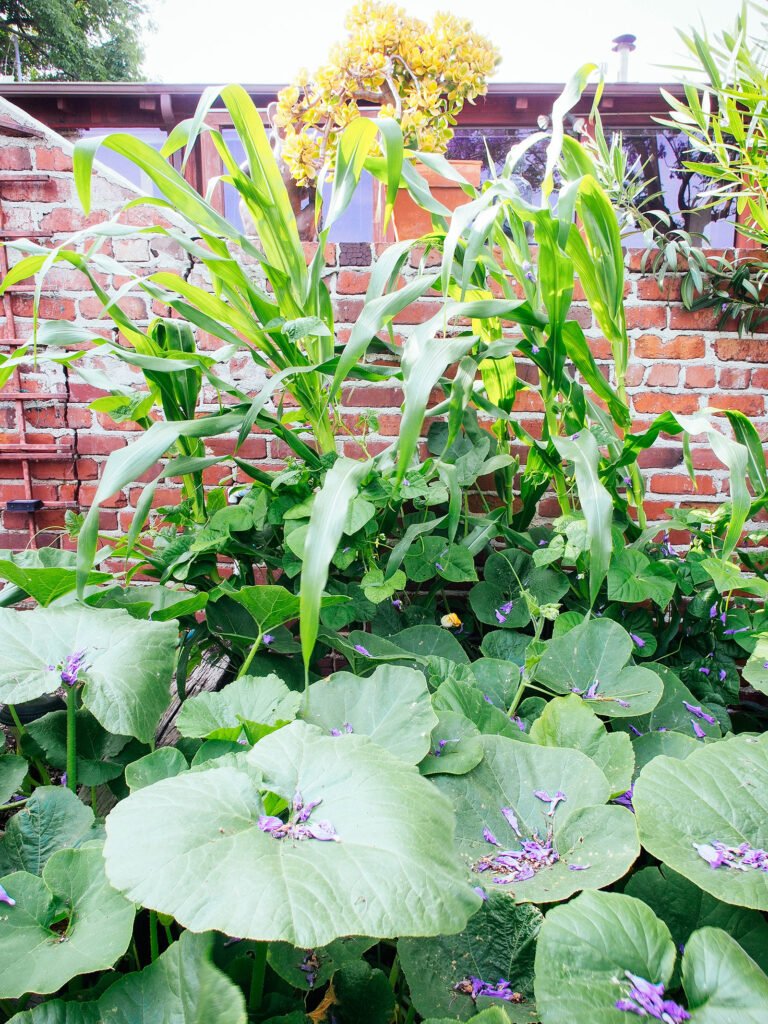
The Three Sisters tradition is a Native American agricultural practice that involves planting three crops together to mutually benefit one another, creating a sustainable and efficient system. The three crops traditionally used are corn, beans, and squash. Each plant serves a specific role to support the others, forming a symbiotic relationship. Here’s how it works:
- Corn: Corn acts as a tall support for the bean vines to climb, keeping them off the ground and allowing them to grow upwards. The tall corn stalks provide structure for the beans to thrive.
- Beans: Beans are legumes that fix nitrogen in the soil, which is a crucial nutrient for plant growth. They grow around the base of the corn, using the corn stalks as a natural trellis. In return for this structural support, the beans help replenish the soil with nitrogen, benefiting all the plants.
- Squash: Squash is planted at the base of the corn and beans. Its broad leaves act as a natural mulch, shading the soil and preventing weeds from growing. The squash’s sprawling vines also help retain moisture in the soil and protect the roots of the other plants from drying out.
This combination of crops minimizes the need for artificial fertilizers and reduces pests and diseases, making it an environmentally friendly and efficient method of farming. The Three Sisters planting method creates a self-sustaining garden where each plant supports the others, making it a powerful example of companion planting.
10. Potatoes & Marigolds: Double Duty Pest Control

Potatoes: These starchy tubers prefer cool weather and loose, well-draining soil.
Marigolds: As mentioned previously, these cheerful flowers offer fantastic pest control benefits.
Why this combination works: Marigolds not only deter pests like aphids and whiteflies that can harm potato plants, but they also act as a trap crop, attracting these insects away from your precious potatoes. Additionally, marigold roots are known to release a substance that can help suppress nematodes, a type of soil-borne pest that can damage potato tubers.
Planting Tips: Plant potato seed potatoes in rows spaced 12-18 inches apart, ensuring they receive full sun. Sow marigold seeds around the perimeter of your potato bed or in between the rows, maintaining a spacing of 8-10 inches. Both plants appreciate consistent watering, especially during tuber formation for potatoes.
11. Mint & Tomatoes: A Fragrant Defense
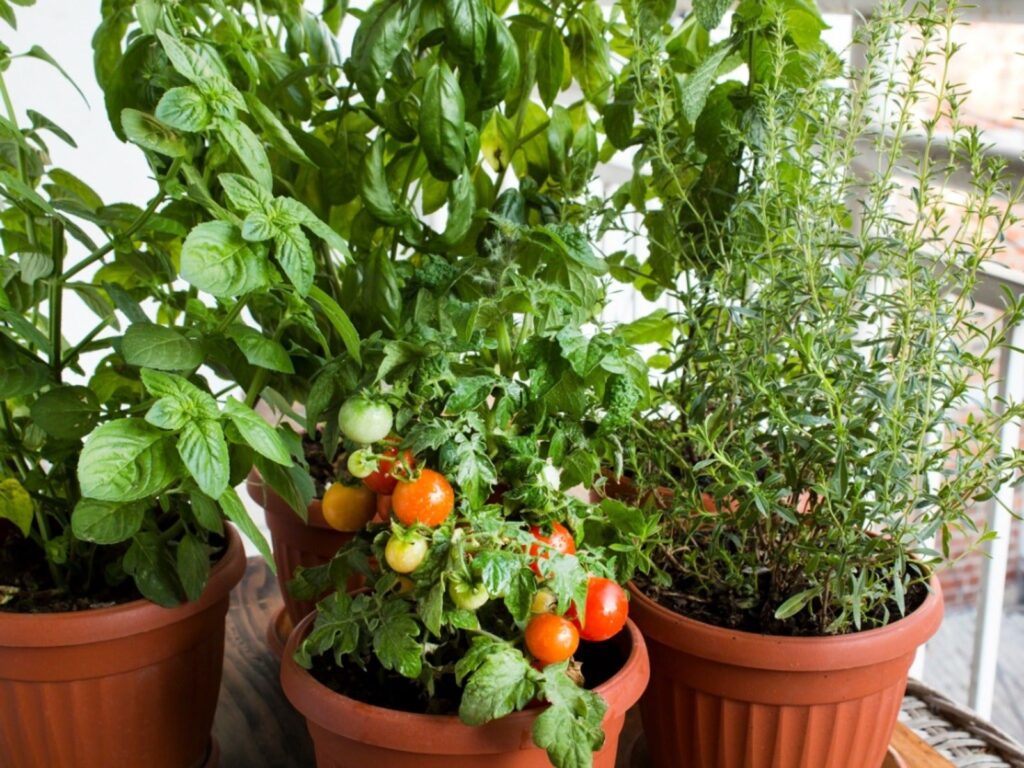
Mint: This aromatic herb comes in various varieties and prefers moist soil with partial shade. However, some mint varieties can be quite invasive, so planting them in containers is recommended.
Tomatoes: As we know, these juicy fruits thrive in full sun and well-draining soil.
Why this combination works: The strong scent of mint can deter some common tomato pests like tomato hornworms and aphids. While the exact science behind this isn’t fully understood, anecdotal evidence suggests mint repels these unwanted visitors. Additionally, planting mint near tomatoes can improve air circulation around the plants, potentially reducing the risk of fungal diseases.
Planting Tips: Plant tomatoes in full sun, spacing them 2-3 feet apart. Plant mint in pots with well-draining potting mix and bury the pots partially in the soil near your tomato plants. Ensure the mint receives partial shade and consistent watering.
12. Eggplant & Peppers: Sharing a Sunny Spot
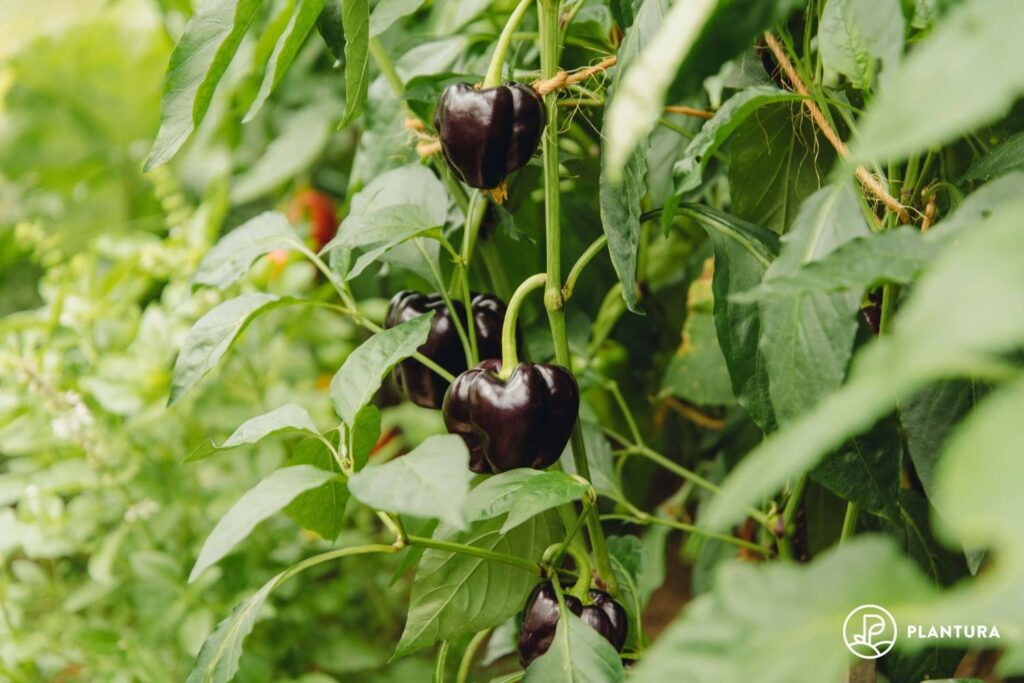
Eggplant: These versatile vegetables enjoy warm weather and full sun. They require well-drained soil and consistent moisture.
Peppers: As mentioned earlier, peppers thrive in similar conditions, preferring full sun, warm temperatures, and consistent watering.
Why this combination works: Both eggplants and peppers are heavy feeders and benefit from similar growing conditions. Planting them together allows for efficient use of space and resources in your garden. Additionally, some believe the strong scent of eggplant leaves can help deter certain pests that might target peppers, like potato beetles.
Planting Tips: Plant pepper seedlings in full sun, spacing them 18-24 inches apart. Transplant eggplant seedlings at a similar spacing, ensuring they are positioned to receive full sun as well. Both plants appreciate consistent watering, especially during fruit development.
13. Carrots & Leafy Greens: A Sequential Symphony
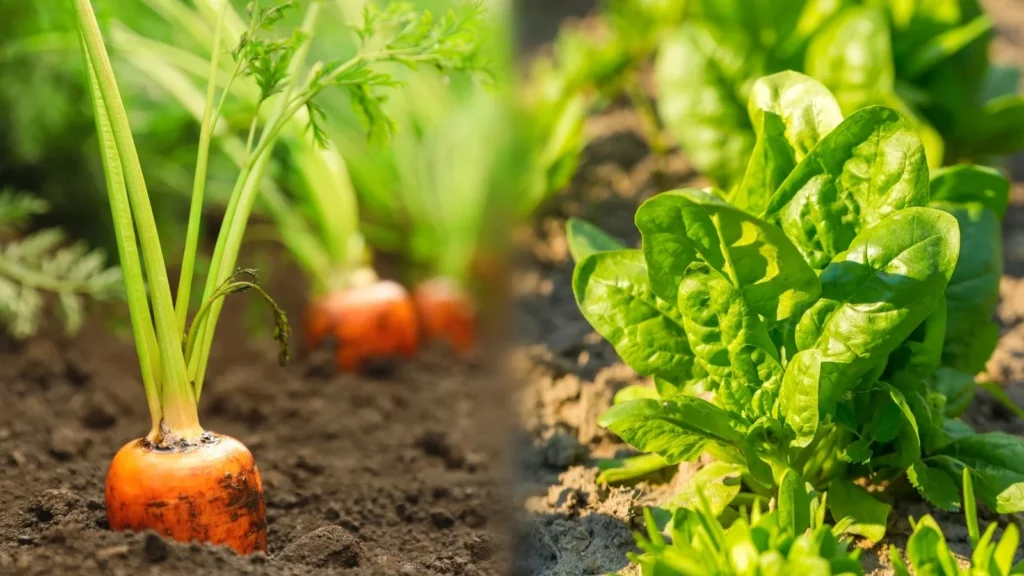
Carrots: These orange root vegetables prefer cooler temperatures and well-draining soil. They require consistent moisture during germination but prefer drier soil as the roots mature.
Leafy Greens: Spinach, lettuce, arugula, and other leafy greens enjoy cool weather and partial shade with moist soil.
Why this combination works: This companion planting strategy utilizes the concept of succession planting. Leafy greens, with their fast maturity time, can be planted in the same bed as carrots earlier in the season. Once the leafy greens are harvested, they leave behind space for the carrot roots to continue growing without competition. Additionally, the shade provided by the leafy greens during their early growth stages can help regulate soil moisture for the developing carrots.
Planting Tips: Sow leafy green seeds directly in the garden bed a few weeks before the last frost. Space leafy green plants according to their variety (typically 4-8 inches apart). Sow carrot seeds in rows spaced 12-18 inches apart a few weeks later, directly seeding them where they will grow to maturity. The leafy greens will be harvested before the carrots require the full space in the bed.
14. Herbs & Roses: Beauty and Benefits
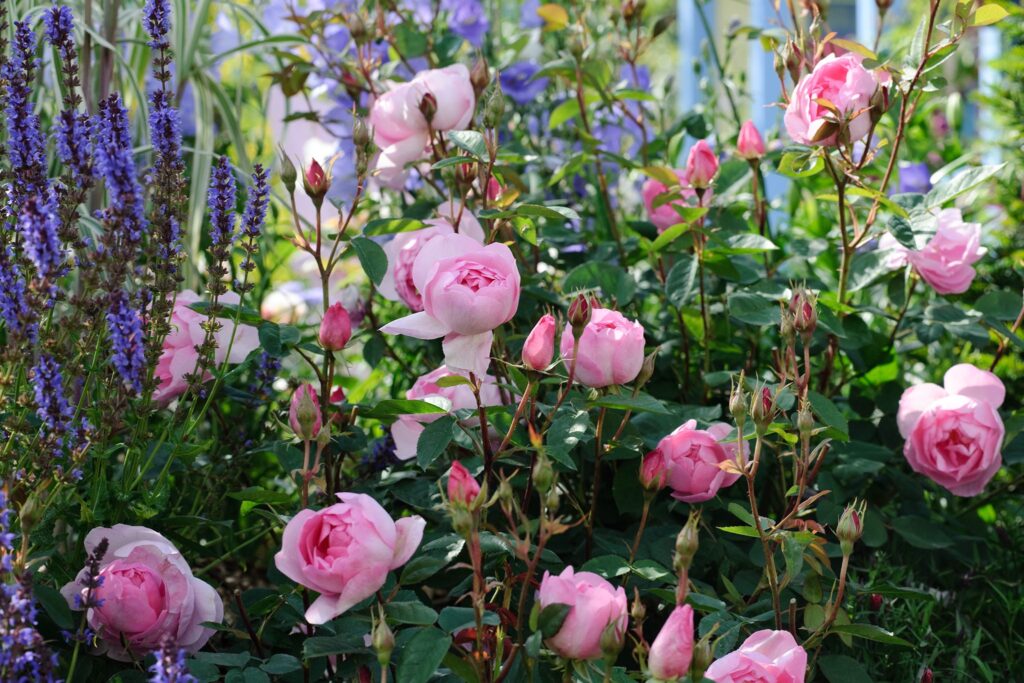
Herbs: Rosemary, thyme, lavender, and other fragrant herbs add beauty and flavor to your garden. Their needs vary depending on the specific herb, but most prefer well-draining soil and moderate watering.
Roses: These elegant flowers are known for their beauty and fragrance, but they can be susceptible to various pests and diseases.
Why this combination works: The strong scent of many herbs can help deter some common rose pests like aphids and black spot fungus. Additionally, certain herbs like rosemary are known to attract beneficial insects like ladybugs, which can further aid in pest control for your roses.
Planting Tips: Plant roses in a location that receives at least 6-8 hours of direct sunlight daily. Choose herbs that have similar sun and water requirements to your rose varieties. Plant rosemary or other pest-repellent herbs at the base of your rose bushes, while herbs like thyme can be planted as edging around the rose bed.
15. Sunflowers & Cucumbers: A Towering Partnership
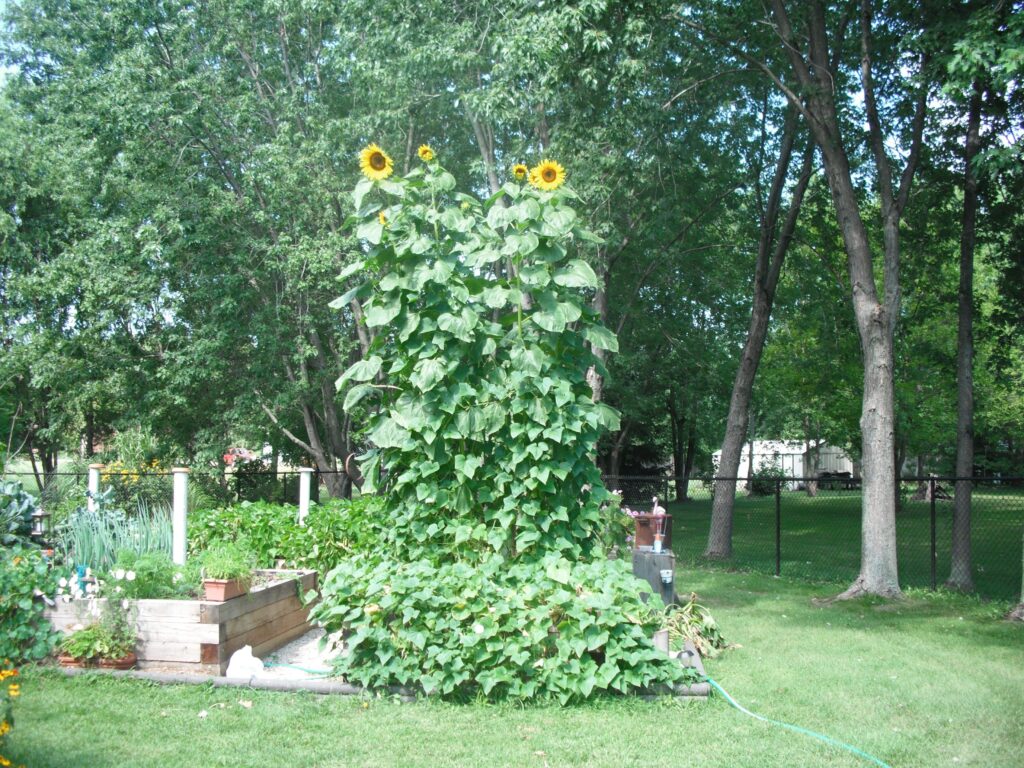
Sunflowers: These giant flowers not only add a dramatic touch to your garden but also attract beneficial pollinators. They thrive in full sun and well-draining soil.
Cucumbers: As mentioned before, these vining vegetables require full sun, moist soil, and consistent watering.
Why this combination works: Sunflowers, with their towering stature, can provide much-needed afternoon shade for heat-sensitive cucumber plants. Additionally, sunflowers attract pollinators like bees, which can also benefit nearby cucumber flowers, promoting fruit production.
Planting Tips: Plant sunflower seeds directly in the garden bed in a location that receives full sun. Space sunflower plants at least 6 feet apart to allow for their mature size. Sow cucumber seeds in mounds spaced 3-4 feet apart, positioning them on the side of the bed that will receive morning sun and afternoon shade from the sunflowers. Both plants appreciate consistent watering.
By incorporating these companion planting combinations and the additional tips provided, you can create a thriving and vibrant garden ecosystem that promotes healthy plant growth and minimizes pest problems. Remember, experimentation is key! Observe your garden and see what combinations work best in your specific climate and growing conditions. Happy planting!
16. Corn & Pole Beans: A Classic Climber’s Paradise

Corn: As mentioned earlier, corn thrives in full sun and well-draining soil with consistent moisture.
Pole Beans: These climbing varieties of beans require support structures and enjoy similar growing conditions to corn.
Why this combination works: This companion planting strategy is another variation on the “Three Sisters” theme. Pole beans utilize the sturdy stalks of corn for support, eliminating the need for separate trellises. In return, the bean plants help fix nitrogen in the soil, benefiting the corn’s growth. Additionally, the leaves of the bean plants can provide some shade for the base of the corn stalks, helping to retain soil moisture.
Planting Tips: Plant corn seeds in rows spaced 3 feet apart. Sow pole bean seeds a few weeks later, placing them at the base of the corn stalks. Ensure the corn receives full sun throughout the day. Water both plants consistently, especially during hot weather.
17. Herbs & Squash: A Fragrant Feast

Herbs: Aromatic herbs like thyme, basil, oregano, and savory add a delightful touch to your meals and offer natural pest repellent properties. Most herbs prefer well-draining soil and moderate watering.
Squash: Summer or winter squash varieties sprawl across the ground and enjoy full sun with consistent moisture during the early stages of growth.
Why this combination works: The strong scent of many herbs can deter some common squash pests like squash bugs and cucumber beetles. Additionally, certain herbs like borage are known to attract pollinators that can benefit nearby squash flowers, promoting fruit production. Furthermore, the sprawling leaves of squash plants can help suppress weeds around the base of the herbs, reducing maintenance needs.
Planting Tips: Plant squash seeds in mounds spaced 3-4 feet apart in full sun. Sow herb seeds directly in the garden bed or transplant seedlings at the base of the squash plants or in between the mounds, maintaining a spacing of 8-12 inches depending on the herb variety. Ensure the herbs receive adequate sunlight based on their needs. Water both plants according to their specific requirements.
18. Leeks & Carrots: A Shared Underground Sanctuary
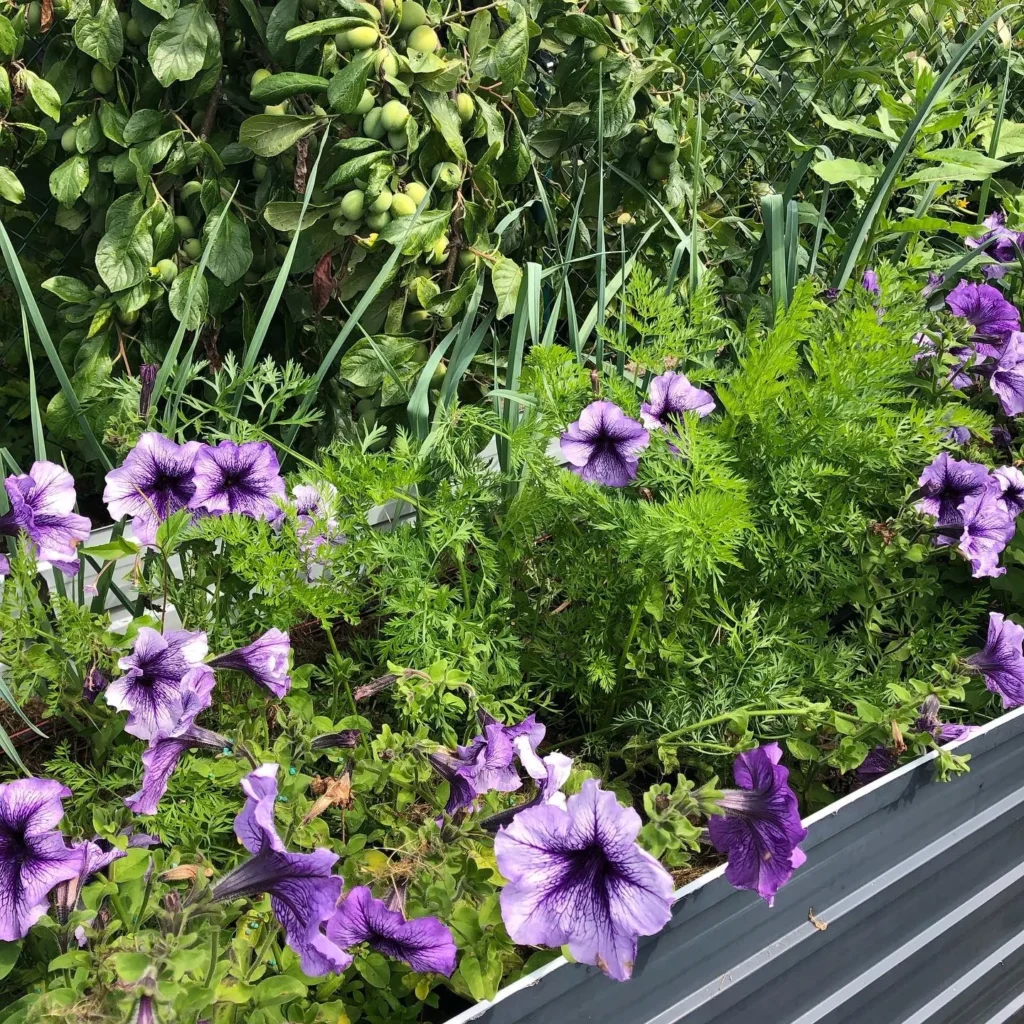
Leeks: These cool-season vegetables thrive in full sun with consistently moist soil. They require loose soil for optimal root development.
Carrots: As we know, carrots prefer cooler temperatures and well-draining soil. They require consistent moisture during germination but prefer drier soil as the roots mature.
Why this combination works: Leeks, with their shallow root system, won’t compete with the deeper taproots of carrots for resources. Additionally, leeks are believed to deter some common carrot pests like carrot flies with their strong scent. This can create a mutually beneficial underground environment for both vegetables.
Planting Tips: Sow leek seeds indoors 6-8 weeks before the last frost and transplant seedlings to the garden in full sun. Space leek plants 6-8 inches apart. Sow carrot seeds directly in rows spaced 12-18 inches apart a few weeks later. Leeks provide some shade for the developing carrots during the hottest part of the day. Water both plants consistently, especially during germination and root development.
19. Lavender and Eggplant: Aromatic Pest Repellent and Pollinator Magnet
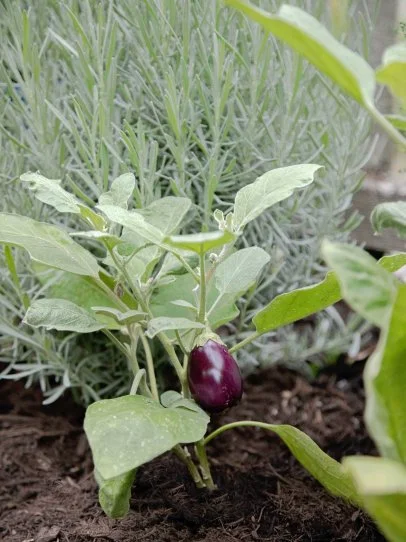
Why it’s unique: While herbs are common companion plants, lavender isn’t always the first one gardeners consider for their vegetable patch. However, its potent properties make it an exceptional partner for eggplants.
The Benefits: Lavender’s strong, distinctive fragrance acts as a natural deterrent against a host of common eggplant pests, including various moths, flea beetles, and even some types of aphids. These pests are often repelled by the aromatic compounds released by the lavender, leading to less damage on your eggplant leaves and fruits. Beyond pest control, lavender is a magnet for beneficial pollinators like bees, which are crucial for the successful fruit set of eggplants. A well-pollinated eggplant plant means a more abundant harvest. As an added bonus, interplanting lavender introduces beautiful colour and a delightful aroma to your vegetable beds, enhancing the overall garden experience.
20. Chamomile and Onions (or other Alliums): The “Helper Herb” for Stronger Growth

Why it’s unique: Chamomile is often thought of as a medicinal herb for teas, but its benefits extend far beyond the teacup into the garden itself. When paired with alliums like onions, garlic, or leeks, it reveals its power as a true “helper herb.”
The Benefits: Chamomile is renowned for its ability to promote the health and vigor of nearby plants. It’s believed to strengthen plant growth and even improve the flavour of surrounding crops. Specifically for alliums, chamomile can help deter onion flies and other pests that target these pungent plants. Anecdotal evidence and some studies suggest that chamomile may secrete compounds into the soil that aid in the development of onion bulbs, potentially leading to increased yields and larger, healthier onions. Furthermore, chamomile’s shallow root system means it won’t compete for nutrients or water with the deeper-rooted alliums. An added bonus for the gardener: you can harvest both for a truly homegrown, health-boosting tea!
21. Nasturtiums and Radishes: The Dynamic Duo of Diversion and Deterrence
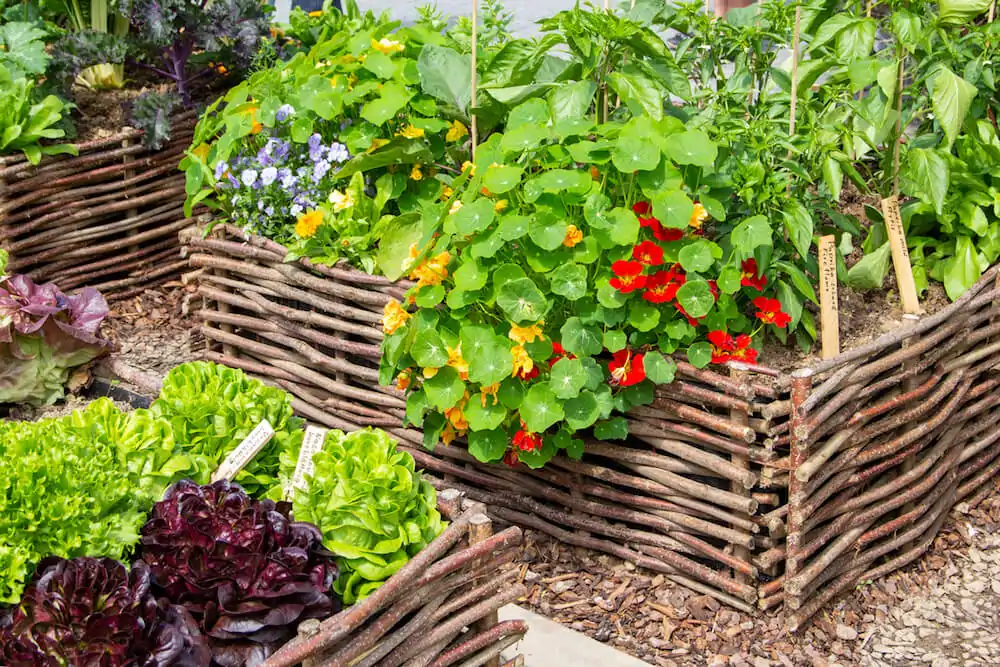
Why it’s unique: This combination cleverly utilizes both plants as “trap crops” or deterrents in a highly effective and strategic manner, particularly beneficial for protecting brassicas (like cabbage, broccoli, and kale) or squash plants.
The Benefits:
- Nasturtiums: These vibrant, edible flowers are famous for their role as “trap crops.” They are incredibly attractive to common garden pests such as aphids and cabbage moth grubs. By planting nasturtiums near your brassicas or squash, you can effectively lure these pests away from your main crops. The pests will congregate on the nasturtiums, leaving your more valuable vegetables relatively untouched. As a bonus, both the peppery leaves and flowers of nasturtiums are edible, adding a unique flavour to salads.
- Radishes: Fast-growing radish varieties, particularly those with white roots like ‘White Icicle,’ can act as subtle “bodyguards” for squash plants. They are thought to release compounds that help to confuse and deter destructive squash vine borers, masking the scent of squash plants and making it harder for the borers to locate their target. Radishes can also serve as a trap crop for flea beetles, drawing them away from more susceptible plants.
Mythbusting Companion Planting
There’s a misconception that simply planting any two specific plants together will automatically create a beneficial relationship. While some combinations have well-documented scientific evidence supporting their effectiveness, others lack strong research. It’s crucial to understand the reasoning behind each companion planting strategy for optimal results.
Planning Your Companion Planting Garden:
- Research is key: Before planting, research the specific needs of each companion plant you choose. Ensure they have compatible sun and water requirements to thrive together.
- Consider plant lifespans: Plant fast-maturing crops alongside slower-growing vegetables to maximize space utilization.
- Don’t overcrowd: Maintain proper spacing between plants to allow for air circulation and prevent competition for resources.
- Rotate your crops: Practice crop rotation each season to prevent pest and disease problems associated with monoculture planting.
Try incorporating these companion planting strategies into your garden design to create a thriving ecosystem that benefits both your plants and the environment. So, get creative, experiment with different combinations, and witness the magic of companion planting unfold in your own backyard!

